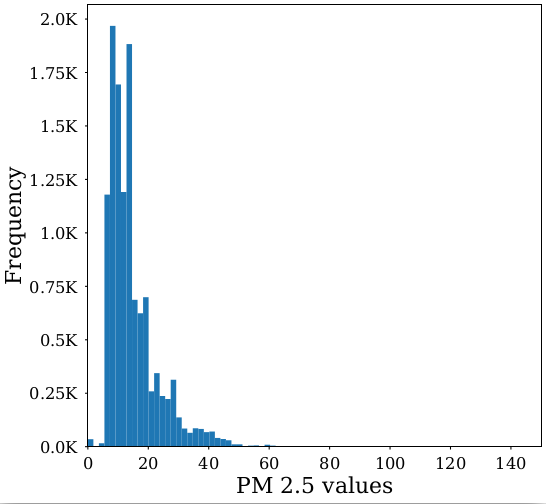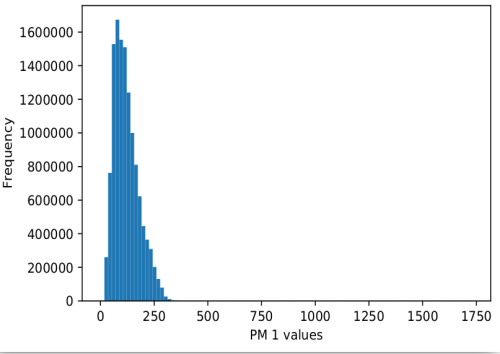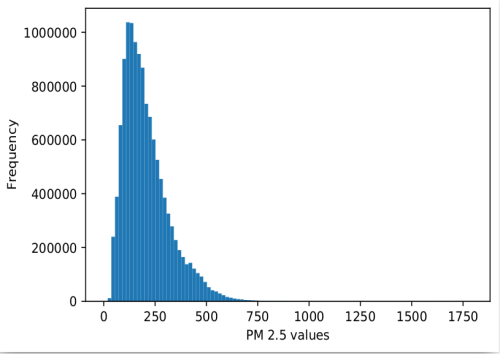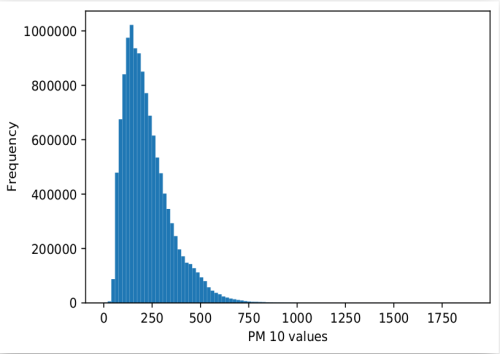Our data is spatiotemporally rich and is one of the only publicly available
datasets for PM values based in a developing country.
The difference between the PM value distributions of a developing and a developed country is staggering.
To corroborate our point and the need for a dataset like ours,
we provide a detailed analysis comparing a mobile air monitoring dataset[2] which belongs to the city
Hamilton in Ontario, Canada collected during 114 days of air pollution monitoring between November 2005
to November 2016 with our
dataset based on a number of parameters.
For the purpose of comparison, we divide Delhi and Hamilton into regions by rounding off the latitude
and longitude of each record to 3 decimal places and the grouping all the record belonging to each
region.
Comparison of Delhi and Canada datasets over different parameters and statistical aspects
The following tables show comparison of Delhi dataset with
canada dataset[2] over different parameters. It also presents statistical
comparison of PM values recorded by both datasets.
The below table provides comparison of Delhi, Canada dataset[2] and Zurich dataset[1] over different metrices
| Metric |
Delhi Dataset |
Canada Dataset |
Zurich dataset |
| Total number of samples |
12542183 |
46080 |
Varying for different pollutants (19.9 - 49.7 Million) |
| Sample with atleast one PM (1.0, 2.5, 10.0) value |
12542183 |
13048 |
- |
| Pollutants covered |
PM1, PM2.5, PM10 |
CO, NO, NO2, SO2, O3, PM1, PM2.5, PM10 |
O3, CO, NO2 and UFP |
| Vehicles used |
Public bus |
Commercial van |
Trams |
| Monitoring Period |
91 days |
114 days |
Varying for different pollutants (2.5 - 4.5 years) |
The table below presents estimate of cost of the other sensors(COx, NOx, SOx). We are currently trying augment
some of our instruments with additional sensors, but this needs careful planning as budgets in
developing countries is scarce. We have started our measurements with PM as accurate PM sensors are available at 2,500 INR.
| Pollutants |
vendor1 (honeywell) |
vendor2 (alphasense) |
vendor3 (winsen) |
| SO2 |
17,337 INR |
8,500 INR |
10,600 INR |
| NO |
14,600 INR |
8,500 INR |
- |
| NO2 |
10,618 INR |
8,500 INR |
10,530 INR |
| CO |
- |
8,500 INR |
4,450 INR |
| CO2 |
- |
- |
2,910 INR |
| O3 |
- |
- |
4,288.28 INR |
The below table provides statistical comparison of PM values of Delhi and Canada dataset[2].
| Metric |
Delhi Dataset |
Canada Dataset |
|
PM1 |
PM2.5 |
PM10 |
PM1 |
PM2.5 |
PM10 |
| Min |
1 |
1 |
1 |
0 |
0 |
0 |
| Max |
1730.5 |
1792 |
1903 |
2640 |
731 |
291 |
| Mean |
120.348 |
207.9248 |
226.1106 |
46.45 |
15.08 |
12.15 |
| Std |
57.2723 |
114.3632 |
123.8647 |
97.36 |
12.87 |
9.02 |
| 5th Percentile |
45 |
72 |
79 |
4 |
6 |
8 |
| 95th Percentile |
233 |
435 |
471 |
28 |
32 |
138 |
| Missing % |
0 |
0 |
0 |
72.24 |
73.62 |
71.71 |
Comparison based on total number of data points collected across all regions
The first parameter used for comparison is total
number of records
collected in every region in the
city across the whole duration of the data. The below figures shows this over the cities of Hamilton and
Delhi.The color of each circle in the maps represent total number of points
collected in every region. As it can be seen from the maps, the circles over most of the regions in
Hamilton are of green color
which corresponds to 0-20 points over a region. But there is a large variation in the color of circles
over Delhi which correspond to more than 500 data points over most regions. This indicates that the
number of data points collected across each region in Delhi is much higher than the number of points
collected across each region in Hamilton.
Total number of data points across all regions
 (a) Delhi PM count
(a) Delhi PM count
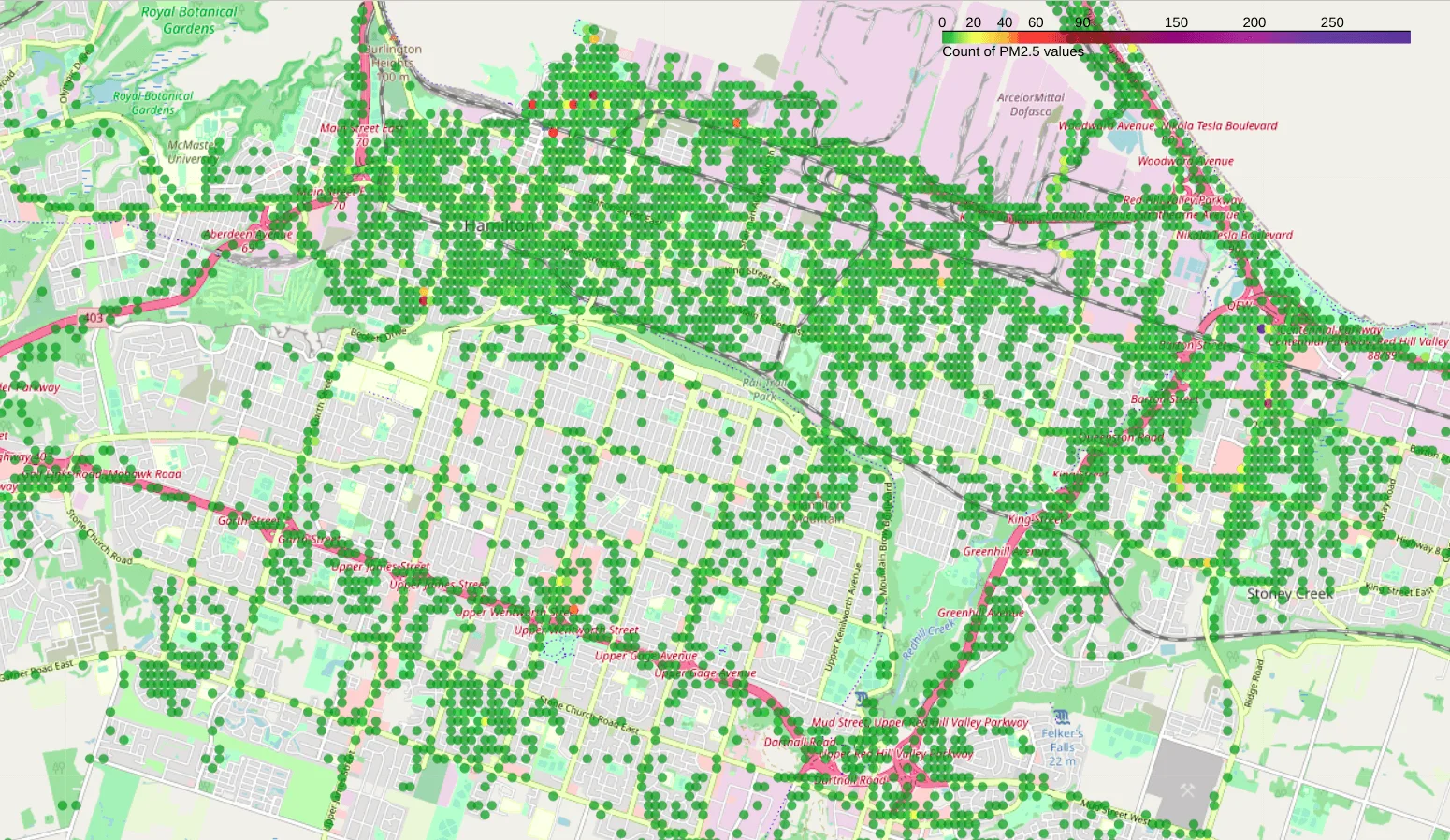 (b) Hamilton PM count
(b) Hamilton PM count
Comparison based on average value of PM2.5 level across all regions
The below graphs show the average of PM2.5 values recorded in every region throughout
the dataset over the cities of Hamilton and Delhi.
The color of each circle in the maps represent average PM2.5 inevery regions
We can observe that the average PM value recorded in most of the regions in Hamilton is in 0-50 range and there are only a few regions
that average of greater than 50. Almost none of the regions record an average greater than 100 across
the whole duration of data.On the other hand, in Delhi we can see that average PM for most regions is greater than 250
which is much higher than any of regions in Hamilton.
Variance of PM2.5 level across all regions
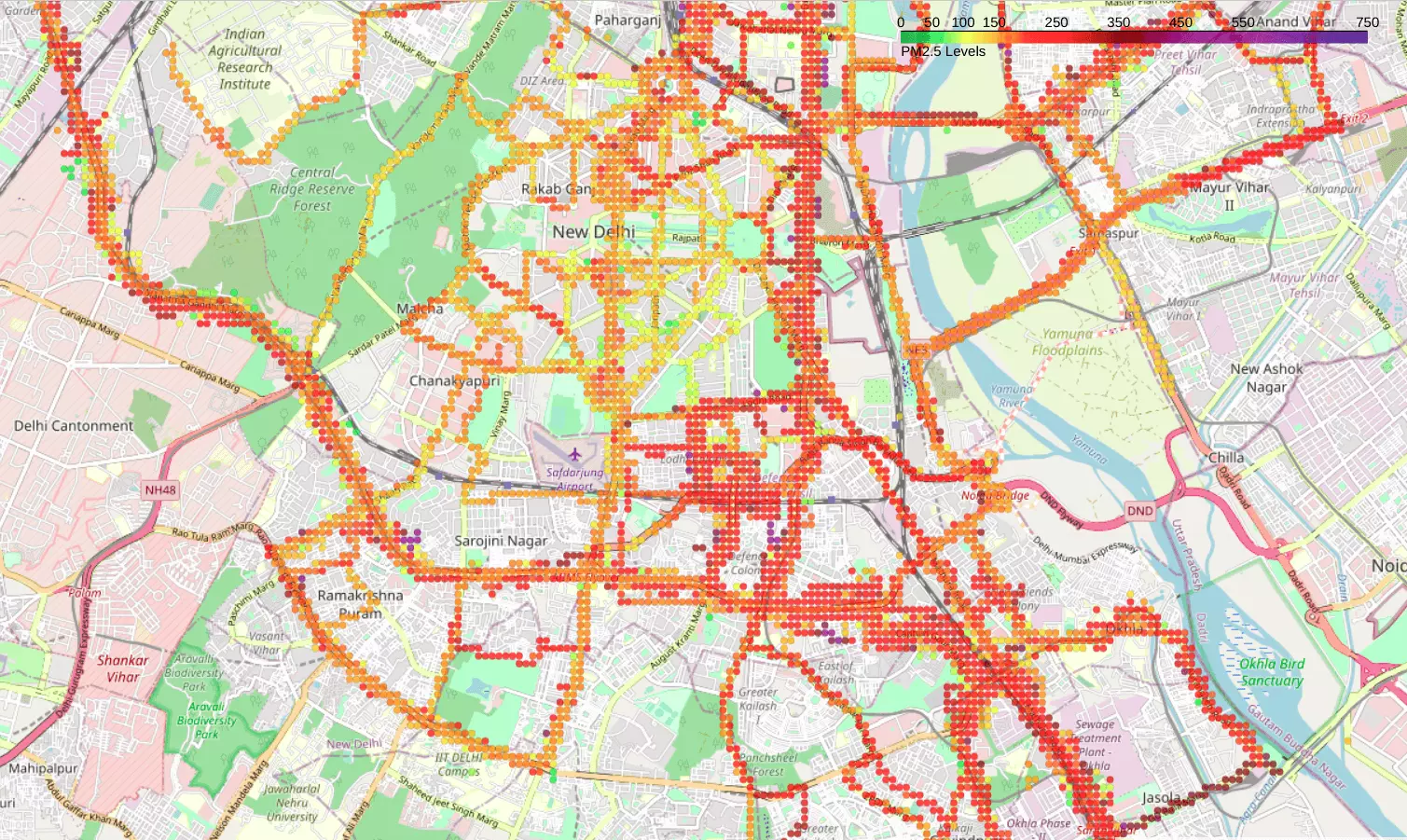 (a) Delhi
(a) Delhi
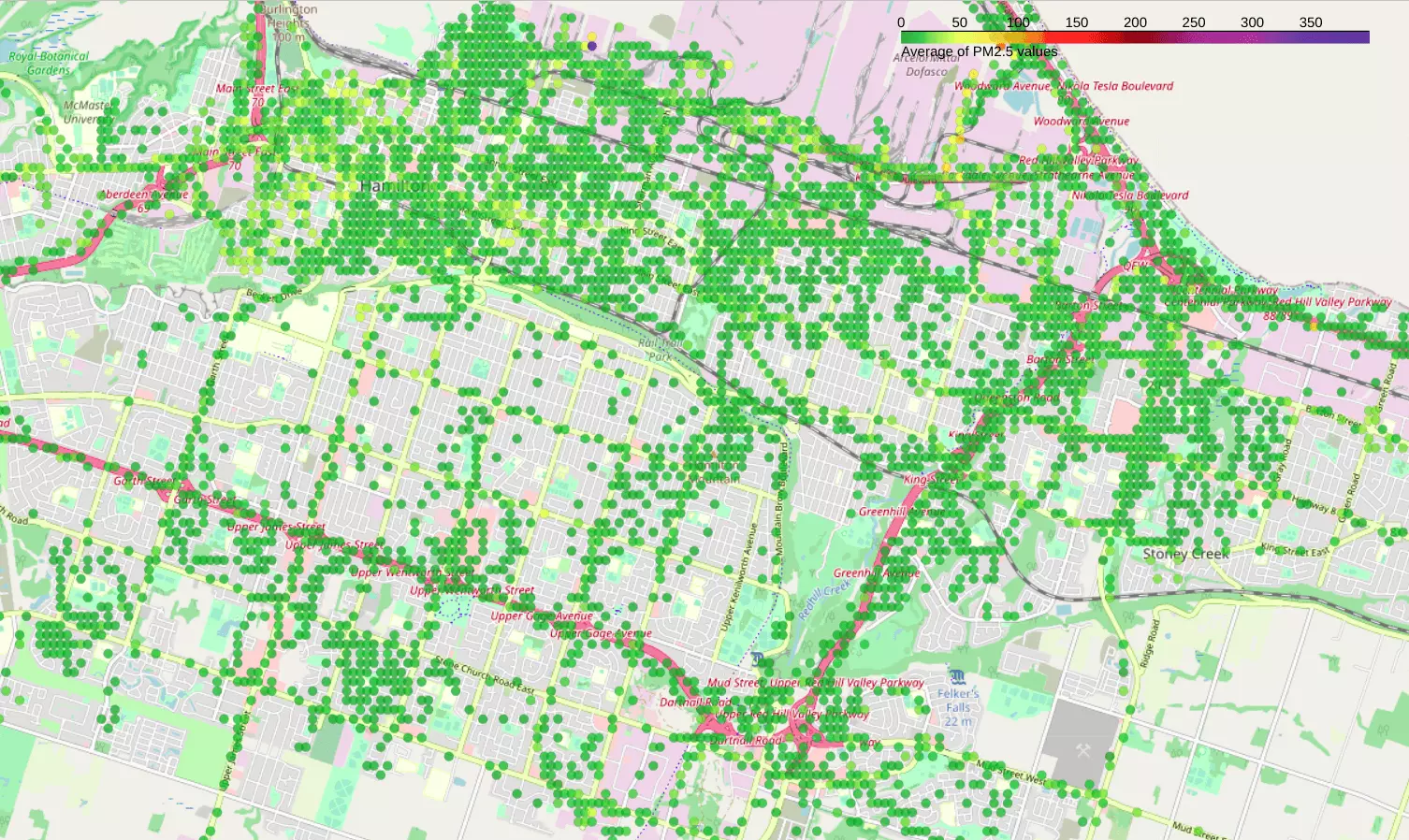 (b) Hamilton
(b) Hamilton
Comparison based on variance of PM2.5 level across all regions
Here, we compare the variance in PM2.5 level in all
regions across the
whole duration of data.
Figure below shows this over the cities of Hamilton and Delhi. The color of each circle in the maps
represent PM2.5 variance in every region.
We can see that for Hamilton, PM2.5 level varies in a very small region of 0-50 across most of the
regions and there are a very few points where the variance is greater than 150. We should also note
that this variance is observed in a period spanning 11 years.
On the other hand, we see very very high variance in PM2.5 levels recorded across almost all the
regions in Delhi and this variance has been observed over just 3 months.
Variance of PM2.5 level across all regions
 (a) Delhi
(a) Delhi
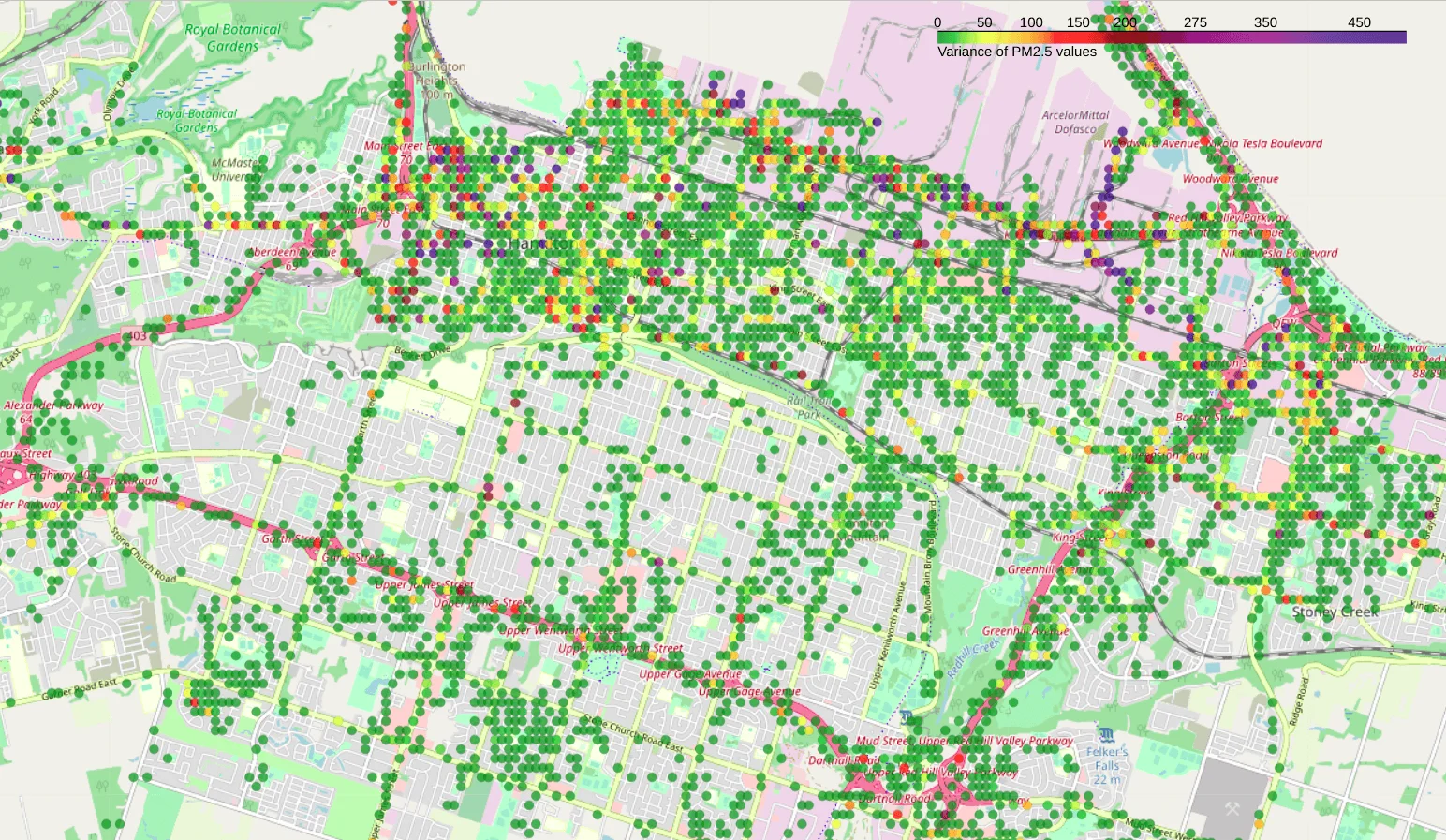 (b) Hamilton
(b) Hamilton
Comparison based on number of hours covered across entire dataset
It is found that in Canada dataset[2], there are some
hours where there are
no samples at all which is
shown using bar plots below. For each hour in a day, we count the total number of minutes which have at
least
one sample across the whole dataset. We observe that in our dataset we have samples for each minute
of each hour. Whereas in Canada dataset[2] there are atleast 9 empty hours and most of them in the
night time
Number of minutes covered across each hour
 (a) Delhi
(a) Delhi
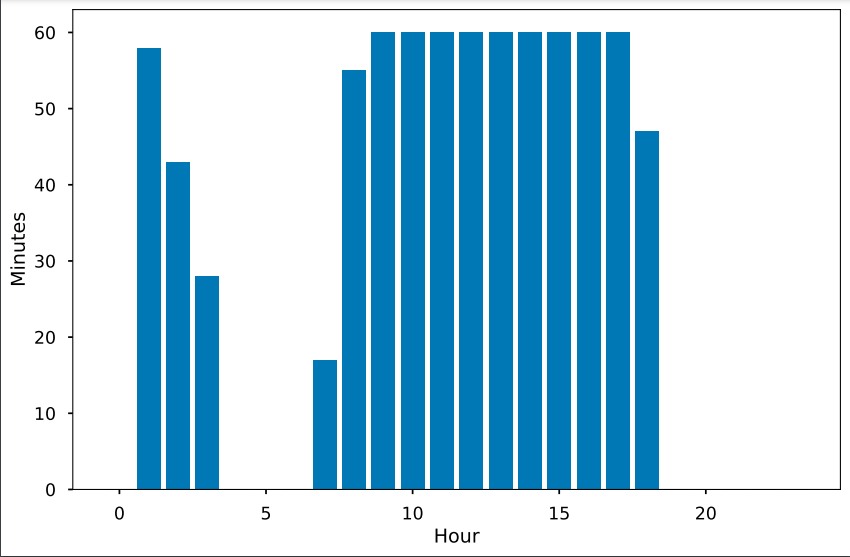 (b) Hamilton
(b) Hamilton
Comparison based on frequency of PM values
Below plots show the frequency of PM values in
Delhi and Canada datasets
respectively. Most of
the PM2.5 values lie in the range of 0 to 60 for the Canada dataset while it is in the range 0 to 750 in
case of Delhi. Not only the range of PM values is high in our dataset but the frequency of each PM
value is also high. Most frequent PM2.5 value in case of Hamilton is around 10 and in case of Delhi
is 150. The above analysis also holds in case of PM1 and PM10 values.
Frequency distribution of PM2.5, PM1 & PM10 values across the entire canada dataset[2]
Frequency distribution of PM2.5, PM1 & PM10 values across the entire Delhi dataset
References
-
Jason Jingshi Li, Boi Faltings, Olga Saukh, David Hasenfratz, and Jan Beutel.
Sensing the airwe breathe: The opensense zurich dataset.
In proceedings of the Twenty-Sixth AAAI Conferenceon Artificial Intelligence , AAAI’12, page 323–325. AAAI Press, 2012.
-
Matthew D. Adams and Denis Corr. A mobile air pollution monitoring data set.Data, 4(1),2019









